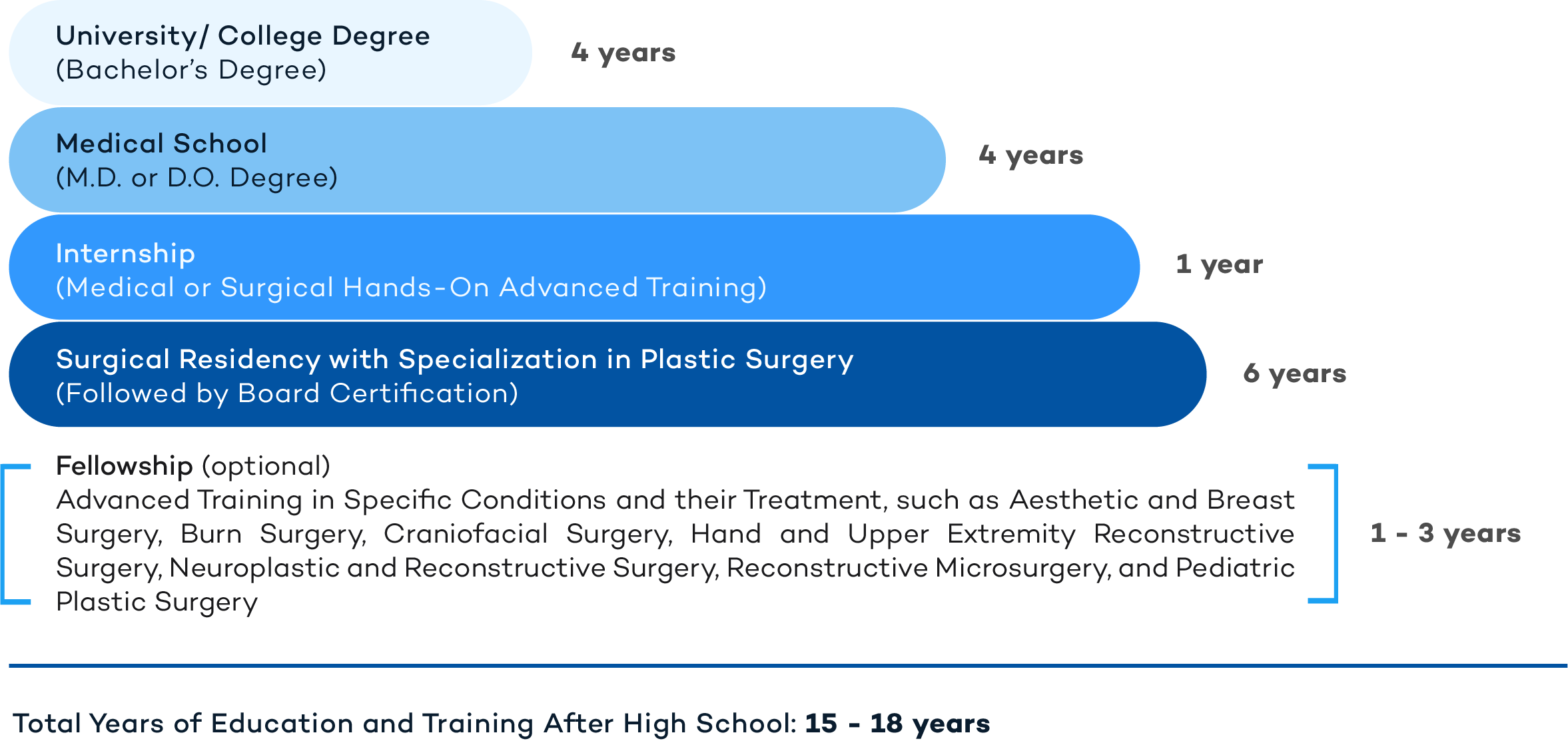

A Plastic Surgeon is a Board-Certified Doctor who performs procedures that change the shape or appearance of part(s) of the body. These include the skin, musculoskeletal (muscle and bone) system, craniomaxillofacial (skull and face) structures, hands, extremities, breast, and the trunk or torso. The plastic surgeon can also perform cosmetic surgical enhancements.
Cosmetic Surgery is an important subspecialty of Plastic Surgery. A plastic surgeon may utilize cosmetic surgical tools and techniques to improve aesthetic appearances or also in the setting of reconstructive procedures.
When looking for a plastic surgeon, it is very important that you choose a physician with the necessary credentials and level of expertise to treat your specific concern. You may do your own due diligence and check for the specific skills, credentials, certifications and level of expertise of the physician, especially pertaining to your specific cosmetic condition. With the help of your family and friends, you can learn about the doctor’s patient satisfaction and see his/her Before & After clinical pictures showing his results.
Given the importance of aesthetics and appearance, it is recommended to see a physician with specialized training in cosmetic surgery. At myDoqter, you have access to patient feedback about doctors, and you can also see the professional recommendations given by other physicians who have witnessed first-hand the expertise and professional competency of your doctor.
Plastic Surgeons are doctors (M.D. or D.O.) with advanced medical degrees and training. The following is a representation of the years of education and training that a plastic surgeon has undergone.

PLASTIC from the Greek word ‘plastikē’ for ‘the art of modelling malleable flesh.’ SURGERY from the Greek roots 'kheír’ meaning ‘hand’ + ‘érgon’ meaning ‘work’.
The Plastic Surgeon has extensive training and expertise in a variety of conditions and procedures that alter and improve the appearance of the body and face, including:
Liposuction: also known as “Lipo”, is a surgical cosmetic procedure for removing excess fat utilizing suction. The most common areas that are treated include the abdomen, buttocks, hips, thighs, knees, chin, upper arms, back, and calves.
Breast Augmentation: is medically known as “augmentation mammoplasty”. This surgical procedure is performed to increase breast size, which involves placing breast implants under breast tissue or chest muscles. It can be performed for cosmetic enhancement or for surgical reconstruction after breast cancer surgery, for example.
Eyelid surgery: is medically known as “blepharoplasty” and is a type of cosmetic surgery that repairs saggy or droopy eyelids by removing excess skin, muscle, and fat tissue.
Tummy tuck: is medically known as “abdominoplasty”. This cosmetic surgery procedure is performed to remove excess fat and skin, and to produce tightening of the middle and lower abdominal muscles. The ‘tummy tuck’ procedure helps to make the abdomen look thinner, flatter and more firm.
Breast Reduction: is medically known as “reduction mammoplasty”. This is a procedure used to remove excess fat, breast tissue, and skin from the breasts, in order to reduce their overall size and to limit physical discomfort and back pain that may have resulted from very large breasts. In some cases, it may be performed for cosmetic preference to achieve a breast size proportionate to the body.
Rhinoplasty: also known as “nose reshaping” or “nose job”, is a surgical procedure for correcting and reconstructing the nose. This is a type of reconstructive surgery that restores the shape and function of the nose after procedures such as skin cancer surgery. A rhinoplasty may also be performed for cosmetic purposes to improve the overall appearance of the nose.
Rhytidectomy: also known as “face lift”, is a surgical procedure that counteracts the effects of time and gravity on the aging face to create a youthful appearance. In this surgery, skin tightening is achieved by removing excess facial and neck skin.
Forehead Lift: also known as a “browlift” or “browplasty”, is a surgical procedure to correct sagging skin on the forehead, eyebrows, and upper eyelids. This technique may be used for cosmetic or reconstructive purposes. In elderly patients, it can help to elevate droopy eyebrows that may obstruct vision. As a cosmetic procedure, it can help remove the deep “worry” lines that run across the forehead.
Gynecomastia Treatment: is also known as “male breast reduction”. In men who have excess breast tissue, this surgery can correct overdeveloped and enlarged breasts, which may have resulted from hormonal imbalances or hormonal changes.
Cleft lip/cleft palate: surgery is used to correct a common birth condition that can produce deformity of the upper lip and palate (roof of the mouth). This deformity can occur alone or in the setting of genetic (inherited) syndromes. The deformity is a result of failure of fusion of the sides of the lip and roof of the mouth in the developing facial structures of the unborn baby. If left uncorrected, cleft palate and cleft lip may lead to difficulty with speech and eating, and to recurring infections.
Craniosynostosis: is a birth defect in which the bones of a baby's skull fuse together too early before the baby's brain is fully developed. This results in abnormal skull growth producing an abnormal appearance and increased pressure in the head. This condition may be successfully treated with reconstructive plastic surgery.
Obstructive Sleep Apnea (OSA): is a condition in which breathing stops involuntarily for brief periods of time during sleep. It results from a blockage or obstruction of the airway, and can be corrected surgically in some cases.
Breast reconstruction: is a procedure that utilizes a variety of plastic surgery techniques to restore the breast shape and contour following mastectomy (surgical removal of one or both breasts to treat breast cancer).
Cosmetic procedures are increasing in popularity exponentially. The growing social acceptance of aesthetic surgery in the media has resulted in increasing numbers of women and men looking to undergo elective noninvasive and invasive procedures to enhance their appearance.
Although cosmetic treatments are exceedingly safe, popular, and effective, they are best performed by a physician with proper training and extensive experience. This physician will also be trained to prevent and/or appropriately handle potential complications and side effects from surgery, such as infection, permanent scarring and deformity. It is equally important that you choose a physician that you are comfortable with and can easily talk to regarding your cosmetic concerns and expectations.
Your Plastic Surgeon will discuss all your options for your specific aesthetic needs, and will work with you to find the best personalized treatment choice and approach.
You can learn more about Plastic Surgery in the following links:
https://www.plasticsurgery.org/news/blog/is-your-plastic-surgeon-board-certified
https://journals.lww.com/prsgo/pages/default.aspx
https://journals.lww.com/co-otolaryngology/Abstract/2006/08000/Preventing_complications_in_facial_plastic_surgery.8.aspx